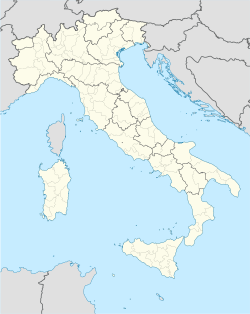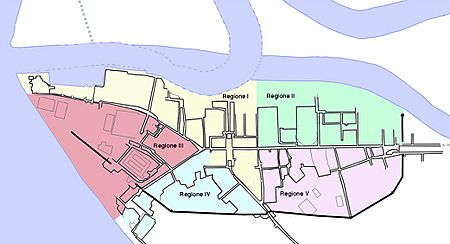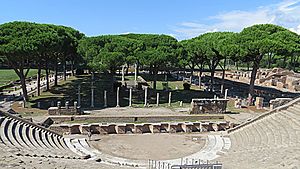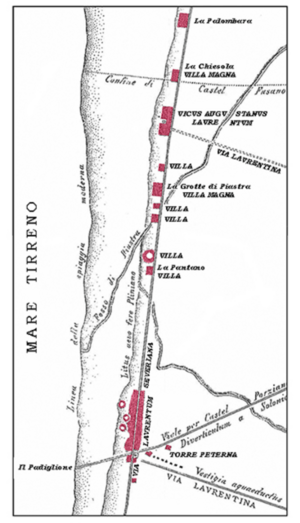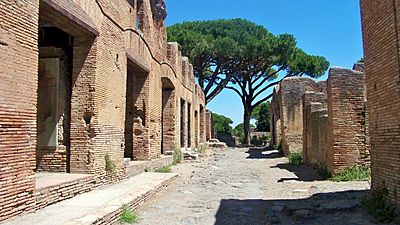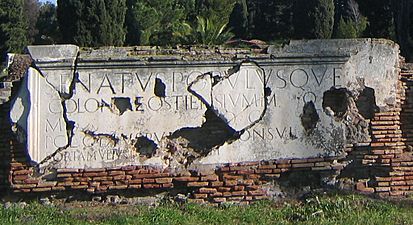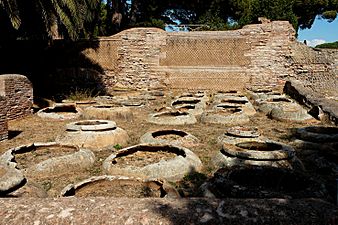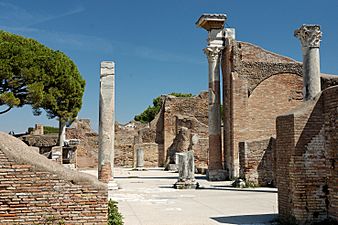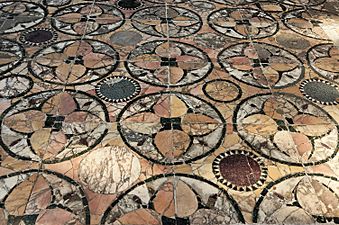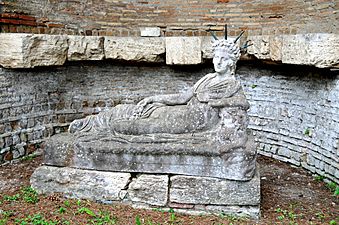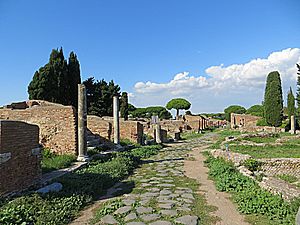Ostia Antica facts for kids

Market square of Ostia Antica
|
|
| Location | Ostia, Lazio, Italy |
|---|---|
| Coordinates | 41°45′21″N 12°17′30″E / 41.75583°N 12.29167°E |
| Type | Settlement |
| Area | 50 hectares (0.50 km2) |
| History | |
| Abandoned | 9th century AD |
| Cultures | Ancient Rome |
| Site notes | |
| Ownership | Public |
| Public access | Yes |
Ostia Antica was an important ancient Roman city. It served as the main port for ancient Rome, located right where the Tiber River met the sea. Today, it's about 25 kilometers (15 miles) southwest of modern Rome. Over time, sand and mud built up, moving the coastline about 3 kilometers (2 miles) away from the ancient city. The name "Ostia" comes from a Latin word meaning "mouth," referring to the river's mouth.
Today, Ostia Antica is a huge archaeological site. It's famous because its ancient buildings, amazing frescoes (wall paintings), and impressive mosaics are very well preserved.
Contents
History of Ostia Antica
How Ostia Antica Began
Ostia might have been Rome's very first colony (a settlement built by Romans in a new area). A legend says that Ancus Marcius, the fourth king of Rome, founded Ostia in the 7th century BC. He first destroyed an older town called Ficana, which had a small harbor. Then, he started the new colony closer to the sea. An old inscription seems to support that the original military camp (castrum) of Ostia was built around the 7th century BC.
However, the oldest remains found by archaeologists are from the 4th century BC. The oldest buildings you can see today are from the 3rd century BC. These include the Castrum (military camp) and a bit later, the Capitolium (a temple for the gods Jupiter, Juno, and Minerva). The strong stone walls of the original castrum show how Romans built cities during the Middle Republic.
Ostia probably started as a naval base. In 267 BC, during the First Punic War, it was home to the quaestor Ostiensis, who was in charge of the Roman fleet. By the 2nd century BC, Ostia became more important as a trading port. It was especially vital for bringing grain into the city of Rome. Because of this, buildings started to spread outside the original military camp.
Ostia During Civil Wars
Ostia saw fighting during the Roman civil wars in the 80s BC. In 87 BC, Marius and his generals attacked the city. They wanted to stop trade from reaching Rome. They captured Ostia and took its riches.
Pirate Attack on Ostia
In 68 BC, pirates attacked Ostia. They set the port on fire and destroyed Rome's war fleet. They even kidnapped two important senators. This attack caused great fear in Rome. To stop the pirates, Pompey the Great helped pass a law. This law allowed Pompey to raise an army and defeat the pirates. He succeeded within a year.
After the attack, the city was rebuilt. New defensive walls were started under Marcus Tullius Cicero, a famous Roman leader.
Ostia in the Roman Empire
The city grew even more during the first century AD. Emperor Tiberius ordered the building of Ostia's first forum, which was a public square.
Ostia's harbor was quite small. So, Emperor Claudius built a new, larger harbor called Portus nearby. This new harbor was not well protected from storms. Because of this, Emperor Trajan later built a stronger, hexagonal harbor in 113 AD. Another port, Civitavecchia, was also developed by Trajan. These new ports took away some of Ostia's business, leading to a slow decline in its commercial importance.
Despite this, Ostia's population grew. It reached about 100,000 people in the 2nd and 3rd centuries AD.
Ostia had everything a city needed back then. It had a large theatre, many public baths (like the Baths at Ostia), lots of taverns and inns, and even a firefighting service. The worship of Mithras was very popular there. Archaeologists have found eighteen Mithraea (temples for Mithras). Ostia also had the Ostia Synagogue, which is the oldest synagogue found in Europe.
Ostia in Later Roman Times
People used to think Ostia slowly declined after Constantine the Great made Portus a separate city. They thought rich people's houses replaced apartment buildings. However, recent discoveries show that Ostia continued to do well. Many bathhouses were still open in the 4th and 5th centuries. The city's Neptune Baths were even repaired in the 370s. In the 4th century, the city grew beyond its southern walls towards the sea.
A poet named Rutilius Namatianus wrote in 414 AD that the city's ports were not being kept up.
Ostia was still prosperous in the 5th century. This is shown by repairs to baths (26 were still working), public buildings, and churches. Streets were repaved, and homes and businesses expanded outside the city walls. A small harbor, the Porta Marina, was built on the sea. A huge villa was built east of the Maritime baths in the 4th century. The river port on the west side of town was also expanded.
Ostia became an important church center (an episcopal see) as early as the 3rd century AD. Saint Augustine mentioned the city when he visited in the late 4th century. His mother, Saint Monica, died in Ostia in 387 AD on their way back to Africa. The church of Santa Aurea in Ostia was built where she was buried.
After the fall of the Western Roman Empire in 476 AD, Ostia slowly fell into ruin. Rome's population shrank from 700,000 in 400 AD to 200,000 or less by 500 AD. A naval battle, the Battle of Ostia, was fought there in 849 AD between Christians and Saracens (Muslims). The remaining people moved to a nearby place called Gregoriopolis.
Surroundings of Ostia Antica
South of Ostia, many large and wealthy villa-estates were built along the coast road to Laurentum starting in the Roman Republic era. Pliny the Younger described the way to his villa there. He said there were two roads. One was from Laurentum, turning off at 14 miles. The other was from Ostia, turning off at 11 miles. He noted that both roads were sandy in places, making carriage travel a bit slow. But they were easy and short for horseback riding. The area had varied scenery, with woods in some places and wide meadows in others. Many sheep and cattle grazed there in the spring.
Today, several well-preserved Roman villas south of Ostia have been dug up. These include the Villa della Palombara, excavated between 1989 and 2008.
Discovering Ostia Antica
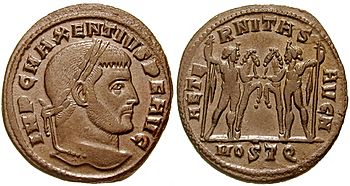
For centuries, the remains of Ostia were used as a quarry. People took marble from the ancient buildings to construct new palaces in Rome.
The Papacy (the Pope's government) started its own digs for sculptures. This began with Pope Pius VII.
Large-scale excavations happened between 1939 and 1942 under Benito Mussolini. During this time, many remains, especially from the Republican Period, were uncovered. These digs stopped when Italy became a major battlefield in World War II.
After the war, the first official book about the "Scavi di Ostia" (Excavations of Ostia) came out in 1954. It focused on the city's layout by Italo Gismondi. After a break, research continues today. Some areas were left untouched to allow for more precise dating of Roman pottery. However, the "Baths of the Swimmer" were carefully excavated from 1966-1970 and 1974-1975. This was partly to train young archaeologists and to create a study collection of well-understood finds.
It's believed that about two-thirds of the ancient city has not yet been excavated.
In 2014, a geophysical survey used tools like magnetometry. This survey found a boundary wall on the north side of the Tiber River. Inside this wall was an unexcavated area of the city with three huge warehouses.
Ostia Antica Today
The site of Ostia Antica is open for visitors to explore.
Items found during the excavations are kept at the Museo Ostiense, which is located right at the site.
Ostia Antica in Media
- Ostia was featured in the novels I, Claudius and Claudius the God by Robert Graves. These books include scenes set in Ostia during the reigns of Augustus and Claudius.
- Ostia appears in A War Within: The Gladiator by Nathan D. Maki.
- Ostia is briefly seen in the 1981 comedy film History of the World, Part I.
- Ostia's beach and port are used in the 1993 music video for "La solitudine" by Laura Pausini.
- Ostia is mentioned several times in the 2005 HBO/BBC historical drama series Rome.
- Ostia is mentioned in the 2000 film Gladiator.
- The "Portus Ostiae" is a wonder you can build in a mod for Sid Meier's Civilization III.
- Ostia is the name of a lost kingdom in the manga series Negima! Magister Negi Magi.
- Ostia is an important city in the Fire Emblem video game series.
- Ostia is mentioned in several novels in Lindsey Davis' Marcus Didius Falco series.
- Ostia is featured in the 1962 film Rome Adventure.
- Ostia is a main location in the children's novel series The Roman Mysteries by Caroline Lawrence and its TV show.
Gallery
-
A statue of Attis from the Shrine of Attis.
See also
 In Spanish: Ostia para niños
In Spanish: Ostia para niños
- Temple of Bellona, Ostia
- Via Ostiensis
- Museo Archeologico Ostiense


